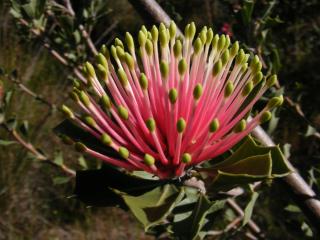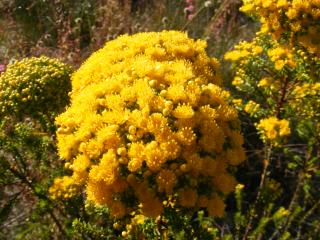Mulching
Mulching is not essential for Australian plants but it does help to reduce evaporation and keep the soil cooler.
Mulches can carry disease, particularly when contaminated with soil and may take nitrogen out of the soil when breaking down. Always use a coarse mulch like wood chips. Fine mulches are not free draining, may blow around and encourage weed growth. Always buy good quality mulch from a reputable source so that you can be sure it is not harbouring fungal diseases.
If you wish to mulch apply it to a depth of no more than 50mm and keep it away from the base of the plant to reduce the risk of collar rot. Repeated applications of mulch over time build up the soil level and promote a layer of organic matter on the surface which can cause problems. This is less of an issue in annual plantings where the mulch can be incorporated into the soil.
An Australian groundcover is a good, living alternative to conventional mulch if you are willing to be patient while it grows and spreads. Stones and well-placed rocks also act as a mulch and can be beneficial for dry area plants that prefer less humidity around them.
Fertilising
Australian plants need only a little fertiliser and the slow or controlled release type is recommended. Over-fertilising is counter-productive because, just like over-watering, it produces lush growth that attracts pests and diseases. Kangaroo paws are particularly susceptible.
For genera that cannot tolerate phosphorus, use a fertiliser specially formulated for their needs. General fertilisers containing phosphate can be used on genera able to tolerate phosphorus, allowing you to grow them in combination with exotics. Read the label to see whether it recommends a dosage suitable for ‘native’ plants, and always use a measuring cup.
Managing pests and diseases
Many Australian plants have small leaves and flowers or large flowers consisting of many small parts. So pest and disease damage creates minimal visual impact.
Many plants tend to attract birds and beneficial insects which keep the pests in check. To maintain this natural balance you should have enough different plants to ensure there are flowers throughout the year. If a plant is chronically affected by insect pests or fungal disease it may be easier to remove it and find a suitable substitute.
The most common problem in home gardens is root rot which may be dieback or a related species of Phytophthora. Soil can be tested for Phytophthora by AGWEST Plant Laboratories.
If dieback is present, ask your nursery or garden centre staff to recommend plants that are tolerant to this disease. Lists of plants and further information on dieback is available at the websites of the Centre for Phytophthora Science and Management at Murdoch University and the Dieback Working Group.
Many Australian plants are susceptible to nematodes. Root knot is the most common type and can be prevalent in older gardens, especially where vegetables or roses have been grown. If you examine the roots of the plant and they are covered with small 2mm round balls or seem excessively branched, then that may be the problem.
Good garden hygiene prevents disease spread while pruning. Clean your pruners and loppers with methylated spirits after using them on a plant that you suspect may be infected—and this applies to exotics as well. Always purchase plants from reputable sources.


